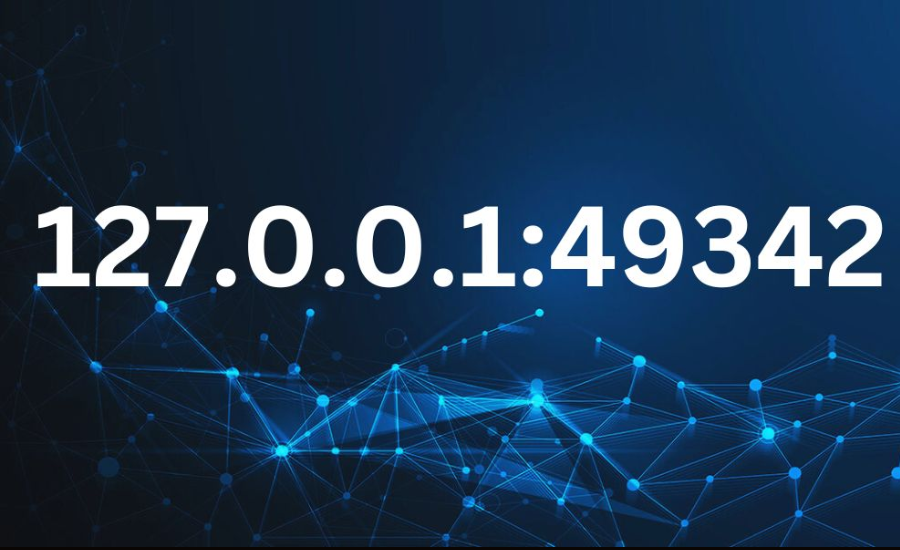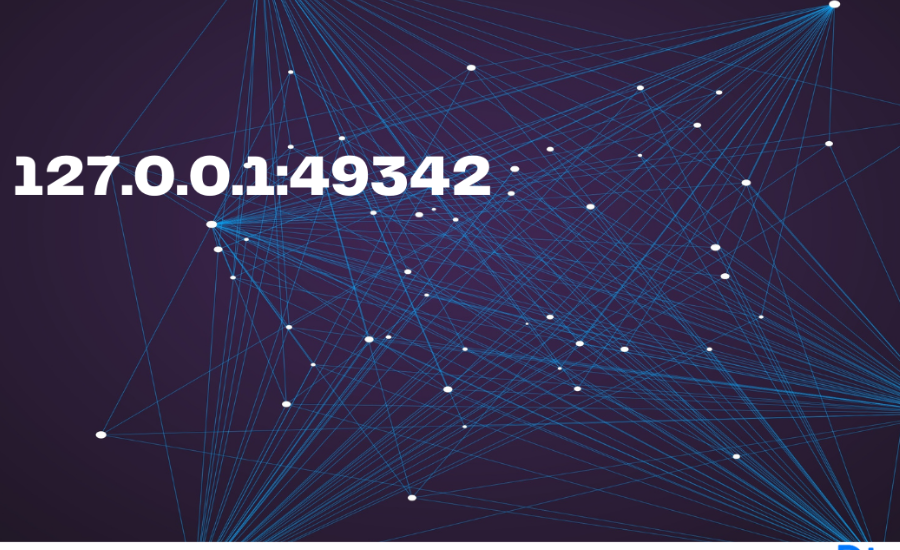Introduction: What Is 127.0.0.1:49342?
The phrase “127.0.0.1:49342” may appear puzzling at first, but in reality, it refers to a specific technical setup used in computer networking. Here, 127.0.0.1 is the loopback IP address, and 49342 represents a port number. This combination plays a crucial role in facilitating internal communication within your computer, allowing it to interact with various software services locally.
This article breaks down the significance of 127.0.0.1:49342 in simple terms and explores its various uses, including testing, security, and local development. Understanding this setup is vital for developers, network engineers, and anyone looking to improve their local testing environments.
What Is A Loopback Address (127.0.0.1)?

At the core of 127.0.0.1 is the loopback address. This is a special IP address reserved for a device to communicate with itself. Instead of sending data out to the wider internet, any traffic directed to 127.0.0.1 stays within the device. This internal loop is used for various purposes, such as testing networking software, running local servers, or debugging applications.
Why Use 127.0.0.1?
The primary reason for using the 127.0.0.1 address is to facilitate local communication without needing an external network connection. Developers often use this address to test applications and services on their machines. It ensures that network communication is self-contained, reducing the risk of exposing unfinished or experimental code to the outside world.
What Is Port 49342?
In the context of 127.0.0.1:49342, 49342 is a port number. Port numbers are identifiers for specific services running on a device. Since a single machine can run multiple services, each service is assigned a unique port to avoid conflicts.
Ports like 49342 are used by developers to run applications locally. For example, a web server or database service might use port 49342 to accept local requests. When accessing a service, you use the IP address followed by the port number, such as 127.0.0.1:49342, which points to a particular service on your local machine.
How Does 127.0.0.1:49342 Work?

When you access 127.0.0.1:49342, your computer knows it should communicate with a service running internally. This setup is essential for developers and testers, as it allows them to interact with local applications just as if they were online, but without any actual internet exposure.
For instance, if you’re developing a web application, you might run it locally on a server like Apache or Node.js, and set it to listen on port 49342. By visiting http://127.0.0.1:49342 in a browser, you access that service running on your own device, enabling a local development environment.
Benefits Of Using Localhost For Testing
Using 127.0.0.1 for testing has several advantages:
- Security: Since no external network traffic is involved, testing and development remain private, preventing vulnerabilities from being exposed online.
- Speed: Local testing does not rely on external servers, leading to faster execution and response times.
- Isolation: Developers can test new features, fix bugs, and experiment with code without impacting live applications or websites.
Common Misconceptions About 127.0.0.1:49342
There are several misconceptions surrounding 127.0.0.1:49342 and localhost in general:
- Not an External Address: Some people mistakenly believe that 127.0.0.1 is a public IP. However, this is only accessible from your own device.
- Port Number Confusion: The number 49342 is just a port and doesn’t represent a unique address. Port numbers simply enable different services to run on the same IP address, each on a different channel.
Setting Up And Using 127.0.0.1:49342

To use 127.0.0.1:49342, you need to configure your machine to run a local service, such as a web server or database. Here’s a basic guide on how to do that:
- Install a Web Server or Service: For example, you can install software like Apache or Nginx for web development, or Node.js for JavaScript-based applications.
- Configure the Port: In your service’s configuration files, set the service to listen on port 49342 (or another port of your choice).
- Test Locally: Once the service is running, open a web browser and navigate to http://127.0.0.1:49342 to access your application.
- Check Service Status: Ensure the service is running smoothly and listening for connections on the specified port.
Troubleshooting Localhost Connections
While setting up localhost addresses is relatively simple, there are some common issues you might encounter:
- Service Not Running: Ensure the software is actively listening on port 49342. You can use network utilities like netstat to check this.
- Firewall Restrictions: Sometimes, firewalls or antivirus software might block connections to localhost. Verify that your firewall allows internal communications.
- Port Conflicts: If another service is already using port 49342, you may need to configure your service to use a different, free port.
Optimizing Localhost Development

For better performance and smoother development, follow these tips:
- Regular Updates: Keep your software and services updated to benefit from bug fixes and performance improvements.
- System Monitoring: Monitor system resources like CPU and memory usage to ensure your application isn’t causing bottlenecks.
- Logging and Debugging Tools: Use logging tools to track any issues and identify potential areas for optimization.
Applications Of 127.0.0.1:49342
While primarily used in development environments, 127.0.0.1:49342 can also be beneficial for other use cases:
- Web Development: Developers use localhost to test websites and web applications before deploying them online.
- API Testing: 127.0.0.1 is ideal for testing and debugging APIs without exposing them to the internet.
- Networking Simulations: Students and network engineers can simulate various network configurations and test network-based software using localhost setups.
- Game Development: Multiplayer games often use 127.0.0.1 for local testing of network features, allowing developers to simulate multiple players on the same machine.
FAQS
1. What does 127.0.0.1:49342 mean?
Answer: The term “127.0.0.1:49342” refers to your computer’s loopback address (127.0.0.1) and a specific port number (49342) used by a service running on your local machine. The IP address 127.0.0.1 is a standard “localhost” address, which routes traffic back to your own device, while the port number represents a specific application or service listening on that address.
2. Why is 127.0.0.1 used in network communications?
Answer: 127.0.0.1 is used to facilitate internal communication within the same device, allowing applications or services to communicate with each other without the need for external network connections. It is commonly referred to as the “loopback address” because it sends the data back to the device from which it originated.
3. What is the role of the port number in 127.0.0.1:49342?
Answer: The port number, in this case, 49342, identifies a specific service or application running on your local machine. Different services, such as web servers or databases, listen on different port numbers to distinguish between various services. Port numbers like 49342 ensure that data is routed to the correct service within your device.
4. Can I access 127.0.0.1:49342 from another computer?
Answer: No, 127.0.0.1 is a local address that only works on the device itself. You cannot access it from another computer or device on the network. If you need to access a service remotely, you would need to use the device’s external IP address and an appropriate port number that is accessible to others.
5. How do I set up a service to use 127.0.0.1:49342?
Answer: To set up a service on your machine to use the 127.0.0.1:49342 address, you typically configure the service’s settings or configuration files to bind to this address and port. For example, in a web server like Apache or Node.js, you would specify 127.0.0.1:49342 as the address and port where the server listens for incoming requests.
6. What are the advantages of using 127.0.0.1:49342 for testing?
Answer: Using the localhost address (127.0.0.1) for testing has several
Conclusion
Understanding 127.0.0.1:49342 is essential for anyone involved in software development, network testing, or even those new to programming. Using localhost addresses effectively creates a secure, fast, and isolated environment for testing and experimentation. By leveraging 127.0.0.1 with specific ports like 49342, developers can confidently create, test, and optimize applications before making them publicly accessible.
Whether you’re a beginner learning how networking works or an experienced developer working on complex systems, mastering 127.0.0.1 and port management is a foundational skill. Keep exploring and expanding your knowledge to unlock even more potential in your local development setups!
Read Next : Magazine Released
